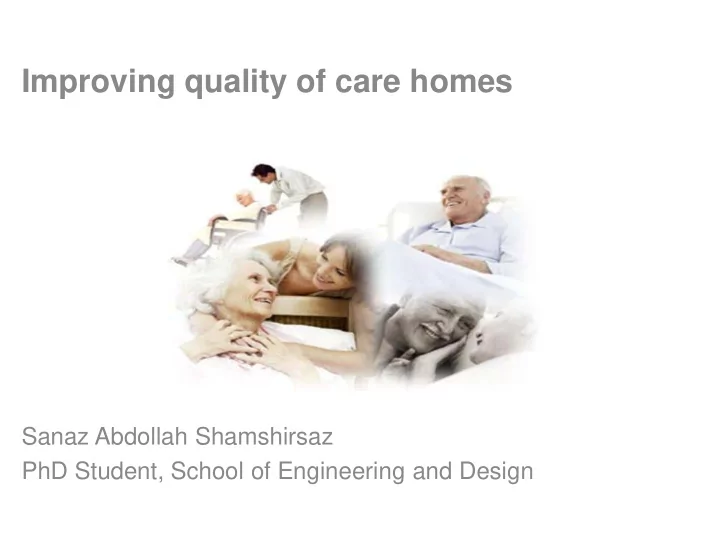

Improving quality of care homes Sanaz Abdollah Shamshirsaz PhD Student, School of Engineering and Design
Number of care homes and places in the UK 376,250 places in 10,331 care homes 9,485 places in 464 care homes 459,448 places in 18,255 care homes 27,700places in 1,164 care homes
Demand for care homes By 2030, the number of care home places will require an 82% increase, about 630,000 extra space
Motivation Caregivers: lack of motivation Environment: risk of physical or mental illness and discomfort Neglect/ Depression: leads to elderly woman's death Malnutrition: a major problem in nursing homes Stereotype: leads to loneliness (65% in Britain)
Aim of the study to describe the use of voice of customer (VoC) analysis in care homes
Outline of the process 1. Identifying the Source of Customer Data Voice of customer Table 2. Identifying Customer Needs and Requirements (DQs) 3. Structuring DQs Comparison Matrix Tree Diagram 4. Ranking DQs
Voice of Customer (VoC) table sample ID of Needs and Customer Voice of Customer (VoC) Requirements Cleanliness “My daughter chose this home because it is very clean.” Room with “I like my room, it has enough space and it is enough space clean.” 01 Usable product in “I like my room but I cannot open the window, the home it’s very heavy for me.” “I love my independency, I can change my Independency cloths and I can eat by myself.” ●●● ●●●
Grouping Needs and Requirements Caregivers Environment Facilities and Residents Activities services Empathic staff Home like Good room Companionship Entertaining environment design activities Quick respond Family visit Quite place Appropriate Lounge food gathering Experienced Autonomy staff Cleanliness Room with Religious Involvement enough and activities Well groomed Good odour good facilities with good Cost personal Outing Safety and hygiene Accurate privacy medical care Celebrations Productivity Suitable Clean sheet temperature Daily living activities Facilitated and usable garden
Ranking Groups Environment Caregivers &Services Residents Comparison Activities Facilities Ranking Weight Matrix 1 2 2 2 3 33.4739 1 Residents 1/2 1 2 1/2 3 19.2257 3 Caregivers 1/2 1/2 1 1/2 3 14.5704 4 Environment Facilities& 1/2 2 2 1 3 25.3685 2 services 1/3 1/3 1/3 1/3 1 7.36152 5 Activities
Tree diagram Companionship _ 6.03 ~ 6 18% Family visit _ 40.5% 13.56~13.6 Residents’ weighting Autonomy _ 27% 9.04 ~ 9.1 based on AHP: 33.5 % Involvement _9.2% 3.00 ~ 3.08 Cost _ 5.3% 1.77 ~ 1.8
Pareto Principle The meeting of few of the most high ranked DQs can significantly increase customer satisfaction (Koch,2005)
Result Highly-ranked requirements weighed by analytical hierarchy process (AHP) Demanded qualities % relative weight % cumulative weight 1 Family visit 13.6 13.6 2 Accurate medical care 10.8 24.4 3 Empathic staff 9.9 34.3 4 Autonomy 9.1 43.4 5 Safety and privacy 6.3 49.7 6 Companionship 6 55.7 7 Appropriate food 4.8 60.5 8 Quick respond 4.5 65 9 Room with enough facilities 4.2 69.2 10 Daily living activities 3.8 73 11 Homelike environment 3.8 76.8 79.8 12 Good room design 3
Conclusions Listening to the voice of resident is vital for quality improvements in care home. Residents are well aware of their need. Key requirements may be determined through interviewing or discussion with a small group of residents.
Engage, Improve, Impact Contact: sanaz.shamshirsaz@brunel.ac.uk hua.dong@brunel.ac.uk
Recommend
More recommend